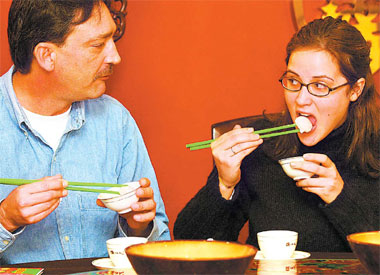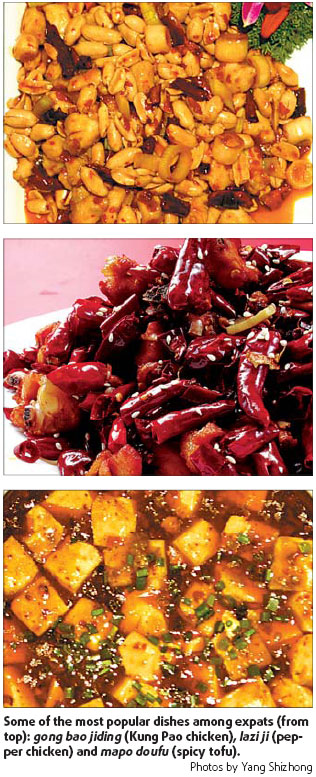Love at first byte
 |
| Chinese menu can be baffling for new expats, however, jiaozi (dumplings) is always a safe bet. Gu Yue |
Being forced to take a punt on menus written only in Chinese characters also makes mealtime a struggle for those with special diets, or simply an aversion to the more exotic flavors of Eastern cuisines.
A new website created by an American expat living in East China's Fujian Province aims to take the heartache out of ordering. www.howtoorderchinesefood.com is designed as a comprehensive guide to Chinese food, geared toward Western palates.
It demystifies the restaurant experience by listing a wide range of dishes, categorized by both ingredients and the region in which they are typically found. Each item is accompanied by a clear picture, with an English description of its contents and flavor.
The name of the dish in Chinese characters can be downloaded and printed out to take to restaurants and match with menu items. The name is also given in pinyin, with tones to assist in pronunciation.

Its creator, Benjamin Ross, says the site is the product of the three years he has spent learning Chinese while living in Fujian. "As long as I can remember I have had a taste for Chinese food. My mother tells me it's because she ate Chinese food every week when she was pregnant," says Ross. "Since my first few days in China, food has always played an integral part in my Chinese studying, and my first two words in Chinese were beef and fried rice.
"As I continued studying Chinese, I never lost my focus on food, as with every new food word I learned, it was a new dish I could add to my Chinese ordering arsenal," he says.
Like Ross, Rita Mei-Wah Choy also used food as a key motivation for learning Chinese. Her website, (www.inu.org/meiwah) though not intended to teach pronunciation, also shares information on ordering from restaurant menus.
"I have never quite been able to sit down to a meal in a Chinese restaurant without wondering if the Chinese characters on the menu said the same thing as the alleged English translations," she says.
"Wondering what goodies I was missing from the Chinese-only specials board on the wall, and if there could be a more efficient way to make sure I got exactly what I thought I was getting."
Her website provides step-by-step instructions for working out the various characters related to eating in China, including how to scan a sign to see what sort of cuisine a place offers.
"The goal is to enable you to look at a restaurant sign and say, 'oh, this place specializes in seafood,' or to look at a mystery-meat dish on a menu and see the Chinese and say, 'ah, it's a lamb dish'," Choy says.
The site is designed as a sort of course, to be worked through in a specific order with a focus on meaning, rather than as a ready reference.
"Reading menus in Chinese is tricky because there is an expected way of doing things, a way of thinking, that has to be grasped, completely apart from the problem of recognizing the characters," says Choy.
With its pictorial focus, Ross' site takes the concept to a new level of user-friendliness. Its function is twofold, he says. First, the site, "allows you to order a vast array of Chinese dishes without having yet mastered the language".
"And if you want to use it as a tool to learn the language, then all the better," Ross says.
The website, launched in late July, is still in its infancy, but has already met with an enthusiastic response from local expats and people planning visits to China.
It serves as an easy reference for those with no China experience to quickly find which classic dishes are most popular with foreigners.
Kung Pao chicken, green pepper pork, sweet and sour ribs, skillet beef, homestyle tofu and stir-fried egg and tomato are included on a central list of all-time favorites.
There are separate ordering guides for vegetarians, as well as lists of dishes made from each type of meat, plus noodle and rice dishes and more.
And, for those who miss their fast food fix, there is even a how-to-order guide to hamburger and other takeaway outlets found in China.
You can learn the Chinese characters for a Big Mac, or how to pronounce Popcorn Chicken next time you find yourself at KFC.
"There is also a glossary to Chinese culinary words. If you've ever wondered how to say shiitake mushroom or MSG, this will be a good spot to look," Ross says.
(China Daily 08/10/2007 page19)














